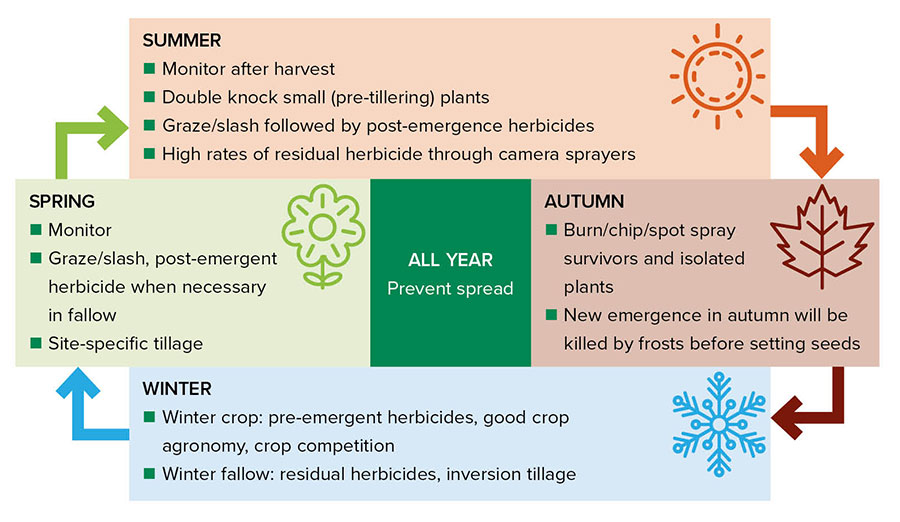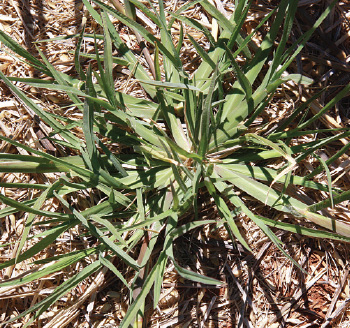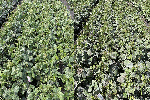Key points
- Feathertop Rhodes grass is migrating south
- With limited registered herbicides,
a zero-tolerance approach is urged - An integrated approach including a combination of residual and post-emergent herbicides, as well as non-chemical methods to reduce the seedbank, has shown control can be achieved after two years
- Winter frosts could also help southern growers manage the weed
Southern region grain growers are being warned by a leading researcher to take a zero-tolerance approach to feathertop Rhodes grass to prevent it from becoming a future problem weed.
Dr Hanwen Wu has been the lead researcher in a four-year, $1.2 million investment by GRDC in partnership with NSW Department of Primary Industries and Regional Development focused on ‘Facilitating adoption of integrated weed strategies for feathertop Rhodes grass in the northern region’.
The project, which finished in June 2023, encouraged growers to take a proactive approach to managing the prolific warm-season grass weed, which has mainly been an issue for northern growers and is now migrating into new areas.
Records show it is now present in every mainland state, with infestations in central western NSW, around Griffith, and scattered populations identified in cropping paddocks and along roadsides in northern Victoria.
Speaking at the GRDC Grains Research Update at Sea Lake in July, Dr Wu says feathertop Rhodes grass is an invasive weed that Mallee and Wimmera growers should do their best to avoid.
 NSW Department of Primary Industries and Regional Development principal research scientist Dr Hanwen Wu spoke at the GRDC Grains Research Update at Sea Lake in July. He urged Mallee and Wimmera growers to do their best to avoid letting feathertop Rhodes grass take hold. Photo: Sandra Godwin
NSW Department of Primary Industries and Regional Development principal research scientist Dr Hanwen Wu spoke at the GRDC Grains Research Update at Sea Lake in July. He urged Mallee and Wimmera growers to do their best to avoid letting feathertop Rhodes grass take hold. Photo: Sandra Godwin
“This is a weed you don’t want,” he said. “It’s very hard to kill, with limited registered herbicides, and it also produces a huge amount of seed. When you see this weed and the seed head coming out, you have to chip it or remove it and bag and burn it before it matures, otherwise you’ll have a headache down the track.”
Each plant can produce more than 40,000 seeds from their mass of tillers, and the seeds are light enough to be easily dispersed by wind to take hold in paddocks and along roadsides, fencelines and on wasteland. Seed is also spread by livestock movement and buying contaminated grain or hay from northern NSW or southern Queensland.
Dr Wu warns the common practice of bare-fallowing paddocks over summer exposes Victorian growers to a high risk of being colonised by this weed, whose seeds can survive in the soil for up to two years.
Integrated approach
Fortunately, an integrated approach using a combination of residual and post-emergent herbicides, as well as non-chemical methods of reducing the seedbank, has shown control can be achieved.
Research at the Wagga Wagga Agricultural Institute has found feathertop Rhodes grass prefers sandier soils, emerging from depths of zero to two centimetres within three days of rainfall. But commonly used pre-emergent herbicides in winter crops and crop competition – especially at canopy closure – during the winter cropping season will impair the weed’s emergence, growth and reproduction.
Figure 1: Seasonal feathertop Rhodes grass management tactics.

Source: NSW DPIRD
Southern advantages
Southern region growers have several advantages over their northern counterparts. These include winter frosts, which will kill plants that emerge during autumn, and the potential to graze any young plants, offering the dual benefit of suppressing the weed and providing extra sheep feed.
However, grazed feathertop Rhodes grass can regrow, so the most effective management is to follow grazing with a post-emergent herbicide.
Glyphosate alone will not control feathertop Rhodes grass and Wagga Wagga Agricultural Institute trials have found the best results are achieved from a double knock with either glyphosate or glyphosate and haloxyfop, followed a week later by paraquat, which achieved more than 90 per cent control of newly regrown plants.
 Young feathertop Rhodes grass seedlings can be tricky to identify, but a major distinguishing feature is the flat base. Photo: courtesy Hanwen Wu
Young feathertop Rhodes grass seedlings can be tricky to identify, but a major distinguishing feature is the flat base. Photo: courtesy Hanwen Wu
Other options, particularly in the case of large infestations, include using strategic tillage to bury seed to depths of 10cm or more.
Dr Wu said control efforts should be focused on the post-harvest period when crop competition has been removed, as the plant develops and matures rapidly in summer.
Prevention is key in areas at the early stage of invasion, which makes monitoring and plant removal the best strategy.
“If you suspect some seed has already set, you need to mark the area for future monitoring,” he said.
“You have to be quite diligent in finding individual plants early so keep an eye on your roadside and fencelines.”
Young feathertop Rhodes grass seedlings can be tricky to identify, but Dr Wu said their main distinguishing feature is the flat base that tillers sprout from, and they are usually a lighter green than windmill grass, which also has a flat base. Leaves are flat, and have prominent fringed or hairless ligules where they join the stalk. They often have sparse, long hairs on the leaf blade margins, especially towards the lower part of the leaf blade.
More information: Hanwen Wu, hanwen.wu@dpi.nsw.gov.au
Resource: Key strategies for the management of Feathertop Rhodes grass
Some treatments in the WWAI trials included herbicides and mixes registered under a minor use permit for control of feathertop Rhodes grass in fallow in Queensland and NSW. The permit (PER91513) expires 31 January 2025.

























































